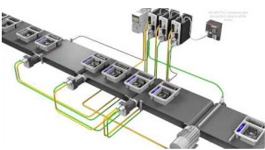Types of PLCs

Programmable Logic Controllers (PLCs) have become very crucial in defining and enhancing industrial production. Their robust construction that includes advanced features such as PID controllers and timers make it easy to program industrial systems for efficient production, easy diagnostics, and safety. PLCs are integrated into production systems as single or module units.
 Integrated / Compact PLC
Integrated / Compact PLC
This type of PLC is constructed using a number of modules that are housed in the same case. This implies that the manufacturer, as opposed to the user, decides the Input/output (I/O) capabilities. Some integrated PLCs are designed to allow connection of addition I/O so that they look more like the module design.
Modular PLC
This type of PLC is constructed with a number of components plugged together into a bus/ rack. In other cases, the rack could have extendable Input/output module capabilities. The PLC has a power supply module, I/O modules, and a CPU module that are plugged together in the same bus. This implies that the PLC is designed as a unit from the same manufacturer/s. Modular PLCs are designed in varying sizes, have varying power supply rates, and computing capabilities. Even the I/O connections are different. You can opt for the large, medium or small modular PLCs based on the memory and input/ output module features.
- Small PLC: This is a small sized PLC created as a compact unit placed alongside the equipment to be controlled. This PLC is used to replace the hard wired logics, timers, and counters. The only issue with the small PLC is that its expandability is limited to one or two modules only.
- Medium-sized PLC: This is one of the common PLCs used in most industries today because it allows more modules to be plugged into it. This means that it can provide hundreds of I/O points via more cards. It also offers more communication module facilities.
- Large PLC: These modules are used for complex control functions. The module capacities are higher than the medium PLC types based on memory communication modules, programming languages, and memory. These PLCs are applied in big plants, supervisory control, and data acquisition systems, and distributed control systems.
To be assured of better performance and value from a PLC, it is also important to stick to brands that are highly committed to delivering quality and value. Some of the leading brands that manufacture PLCs in the market include:
- Siemens PLCs
- Mitsubishi PLCs
- Hitachi PLCs
- Allen Brandley (AB) PLCs
- Omron PLCs
- Delta PLCs
- Modicon PLCs
- Bosch PLCs
- General Electric (GE) PLCs
- Honeywell PLCs
The Application of PLC
 PLCs can be applied to monitor and control any part of an industrial process. In the diagram below, the system sensor and other outputs are fitted in the PLCs output module. Then, the motor is controlled using the output module. Once the sensors are activated, the PLC and the CPU are able to read the inputs and control the conveyor and motor.
PLCs can be applied to monitor and control any part of an industrial process. In the diagram below, the system sensor and other outputs are fitted in the PLCs output module. Then, the motor is controlled using the output module. Once the sensors are activated, the PLC and the CPU are able to read the inputs and control the conveyor and motor.
You can also use The PLCs to control lighting, transmission, switching operations, and distribution systems. However, note that for every PLC to run the hardware requires it’s the right software.
When selecting a PLC for industrial application, it is prudent to consider your system requirements and targeted control. It is also prudent to work with a technical expert and only acquire the PLC that guarantees better results.
